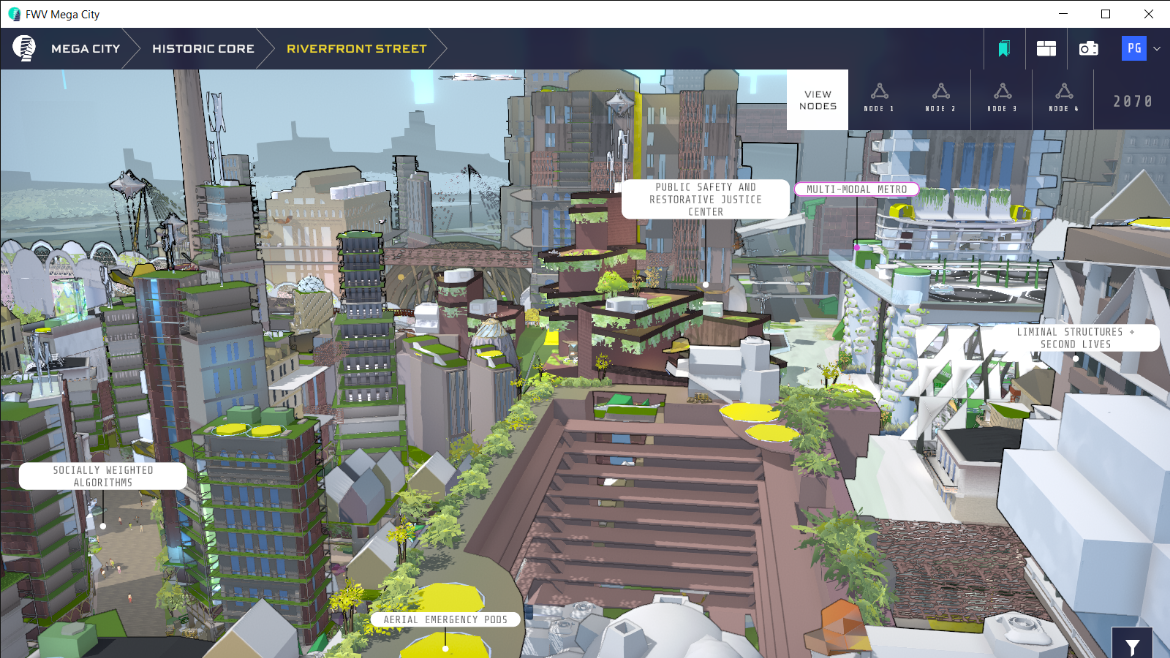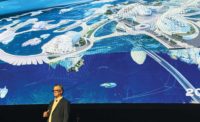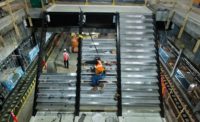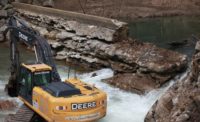Mega City 2070, a new tool from the American Society of Civil Engineers, is designed to jump-start discussions among engineers and others about the future of the built environment and how today's choices will play out over the next 50 years.
ASCE released the beta version of Mega City on Feb. 22 as part of National Engineers Week. Built on the Unity game engine, Mega City offers users a highly detailed look at a theoretical city of 50 million people in the year 2070 with an interactive 3D model. It focuses on six key trends — alternative energy, autonomous vehicles, climate change, smart cities, high-tech construction and policy and funding — through the lenses of different neighborhoods, potential technology and other projected trends. It also looks into issues facing the future city, including construction and materials, energy and utility, architecture, transportation, water and waste and the environment, and the action that will be needed to adapt over the years.
The Mega City 2070 desktop app is available as a free download.
The idea is to ask questions about the future environment that maybe hadn’t been asked before, says Gerald (Jerry) Buckwalter, chief innovation officer at ASCE.
“It's about provoking ourselves to think about the quality of life and the societal benefit we want out of our built environment, before we start designing and building it,” he says.
For an example of the type of questions Buckwalter says the model raises, he points to transportation. How “smart” do roads need to be? If autonomous aerial passenger vehicles become available, what will that mean for road surfaces? If 3D printing becomes the dominant way the world builds things, how will that impact road surface traffic, or maritime traffic?
“The world in which we live is becoming more complex and changing at an accelerating pace,” Dennis D. Truax, ASCE president, said in a statement. “Understanding the drivers of change is more critical than ever. Our future will require a new way of doing things. Mega City 2070 helps connect the dots and ensures all systems are integrated in the future.”
While it may seem like science fiction, Mega City was designed to be a plausible projection of what future cities may contain. To achieve that plausibility, they worked with the same kind of consultants who work for the U.S. Defense Dept. or intelligence agencies to create realistic future scenarios, Buckwalter says. They looked at everything from technology to the environment, to natural resources, to societal expectations, to the economy, and then focused on the intertwined threads of those factors altogether.
Mega City is the latest project from ASCE’s Future World Vision program, and the first of at least five future communities the association hopes to model. They chose the Mega City model for the group's first release because it’s the most relatable considering urbanization trends, Buckwalter says. Also, they wanted to start with a city that would involve less greenfield building than others, and more of building on an evolution of existing cities, which is the nearer-term challenge.
The Future World Vision team unveiled its proof-of-concept for Floating City in 2019, as ENR previously reported. Buckwalter says it was inspired by expectations for evolving coastal resilience strategies that may involve moving offshore. And while rising sea levels will likely push many people further inland, Buckwalter adds that the Floating City concept is again designed to prompt discussions about the future.
“It’s more provocative,” he says. “It forces people to think about coastal phenomena differently.”
The team also has plans for a Rural City model. The opening of the Arctic amid climate change inspired a Frozen City model with the expectation that there will be a need for built environment on permafrost as the world’s supply chain starts moving through the Arctic. There are plans for an Offworld City. There has also been interest in a potential sixth Desert City examining trends for parts of the Middle East and Global South.
The project is the result of collaboration between ASCE, subject matter experts, designers, developers from the firm Experimental Design and futurists. Before joining ASCE, Buckwalter worked on long-term technology planning and developing future scenario assessments for the government.
“I discovered that some version of that was really needed for those who touch the civil built environment, because the same changes that I was analyzing were going to impact our civil infrastructure as much as it’s going to impact our military infrastructure, or national sovereignty issues, or global security,” he says. “But nobody outside the classified community does this with this kind of rigor.”
Buckwalter says the full production version of Mega City 2070 will launch in the fall.






Post a comment to this article
Report Abusive Comment